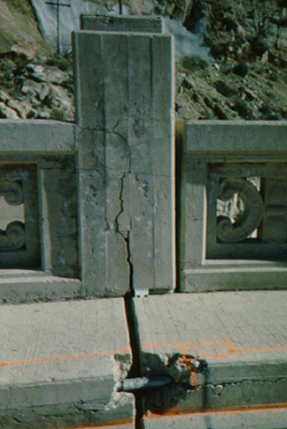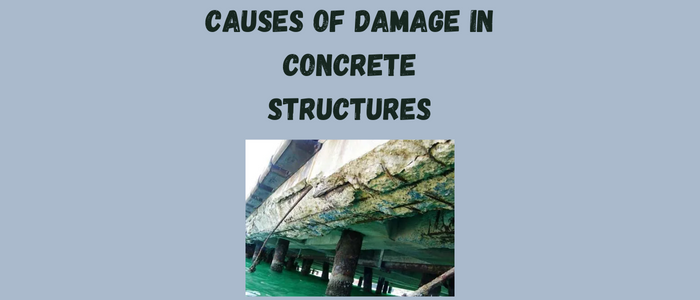Although concrete is considered a durable material for construction, there are factors that cause damage to this durable material. In this article, we discuss some causes of damage in concrete structures.
Even if concrete is made with good quality, there is still a chance it can be damaged if the surrounding conditions are harsher than the design conditions.
Every time damage or degradation in concrete is found, many causes of the damage to the building should be investigated.
Single or Multiple Damage?
So, is there a single mechanism that causes concrete damage at a time?
The answer is may be.
Sometimes there will be a single damage mechanism that cause the damage to concrete.
In other case, there might be multiple mechanisms acting at the same time.
It’s possible that the repairability will be poor if all the causes of damage are not identified and eliminated.
Damage Mechanisms of Concrete
Let us look at the following image:

This concrete is damaged by more than one mechanism:
- Alkali-aggregate reaction, which caused the form of map cracking that appear on the concrete surface.
- Freeze-thaw damage that accelerated the rate of damage.
- Poor construction practice in the selection of the location of electrical conduits. The location was too close to the exterior surface of concrete.
So, to protect concrete, these conditions need to be considered in the design of concrete mixture from the beginning.
For example, to protect concrete from the freeze-thaw damage, air entraining admixtures are used in concrete to cause a volume of air in concrete from 5% to 8%. This air volume will protect concrete from the freezing and thawing damage to a great extent.
The resistance of concrete to freeze-thaw damage has been considerably enhanced by the proper application of air entraining admixtures. Deterioration from freeze-thaw exposures shouldn’t happen unless they are exceptionally severe.
Thus, if concrete was damaged due to freezing and thawing, then, before blaming freezing and thawing conditions, it is advisable to first identify the reasons why the air entraining admixture was ineffective at protecting concrete.
Mix records and aggregate quality test results may indicate that the concrete was poorly proportioned or that the available aggregate was of low quality.
Records of construction inspections may show that placement and finishing methods adopted were poor.
Petrographic examination of the damaged concrete may show that different types of damage mechanisms caused the damage such as:
- Alkali-aggregate reaction
- Sulfate attack
- Chloride attack
When these mechanisms happen to concrete, it can make it easy for the freezing-thawing damage to occur also.
All of these observations could suggest that the issue is far more extensive than originally assumed and calls for more thorough preventative or remedial action than the straightforward repair of the currently degraded concrete.
Low concrete durability can be attributed to a number of factors, including the use of too much mixing water, the inappropriate kind of Portland cement, poor construction methods, inappropriate mixture proportioning, dirty or inferior aggregate, and insufficient curing. Such concrete might not hold up well to threats or typical weathering.
Determining which is the accelerating cause and which is the weakening cause can help in choosing the appropriate procedures and materials for repairing concrete affected by several causes. It is sometimes important to take precautionary steps to safeguard the remaining original concrete from further harm after the weakening cause has been identified and properly understood.
In this regard, the use of concrete sealing chemicals or a thin polymer concrete overlay may be beneficial. If no such preventative measures are deemed useful, the damaged concrete can be repaired using appropriate techniques, but a limited repair life and the possibility of more damage should be expected.
Causes of Damage in Concrete Structures
Read Also:
